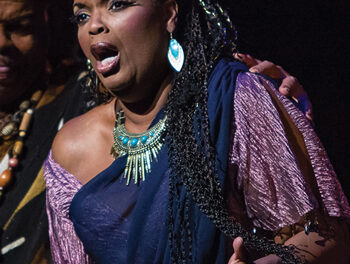This fascinating book chronicles a program in a Winston-Salem, NC, elementary school conceived and managed by its authors to bring music into primary grade classrooms, not to teach music, per se, but to use it as a tool to enhance learning among pupils who are disadvantaged and/or otherwise challenged (by dyslexia or ADD/ADHD, for example). The goal is to help them learn to read and write, to count and calculate, to think and understand — not to learn to read and perform music, although they did have a chance to create (as in compose) some music, in an exercise that, as reported, is truly engaging. Imagine that! Peter Perret is the former (for 25 years) Music Director and Conductor of the Winston-Salem Symphony (and a CVNC writer), and the musicians who formed the woodwind quintet that carried out the experiment were members of that orchestra, selected not only for their consummate skills as musicians but also for their interest in children and intuitive pedagogical techniques. Janet Fox is a freelance arts and education writer and the symphony’s former public relations director.
The school was Bolton Elementary, where at the outset the majority of the students (over 60%) were performing below grade level in statewide measurement examinations. At the conclusion, after three years of exposure at the rate of two or three 30-minute visits per week for from seven to twelve weeks, for a total of about 9 hours per school year, those who participated were in large measure (85-89%) performing at or above grade level in the third grade end-of-year tests. Does it sound too good to be true? Read the book and you will be convinced that music may make a difference in the way the brain develops. The experiment is being continued in more scientific and less empirical fashion in an arts-based charter school in Winston-Salem, and other school districts around the nation, most notably Tucson, AZ, where they have taken the concepts and modified them for use in their contexts.
Perret had a hunch, did some thinking and reading, conceptualizing and organizing, talking and persuading to gain support (moral and financial) for the experiment, and forged ahead. The quintet worked as a team in tandem with the classroom teachers and engaged the pupils in Socratic dialogue concerning what they were doing, discussing the nature of their instruments and of the music they were playing. Many chapters are organized following a sort of pattern: the interactive activities of the musicians with the pupils are described, the latter’s behavior observed and then analyzed upon reflection, proceeding from concrete examples to abstract principles. Some, like many musical compositions, are cyclical in nature, ending up where they started after a thorough development of their subject. Scientific studies and research, duly referenced in the endnotes, are cited in support of the processes and the results. The authors’ scholarship is impressive, but they are nonetheless modest and humble, claiming no “miracle cure”; they clearly state that scientific proof of a cause and effect relationship between the use of music and the test score improvement is absolutely not yet available.
The work opens with a testimonial forward by poet Maya Angelou, a dense introduction by Frank B. Wood, Ph.D., Professor of Neurology and Head of the Section of Neuropsychology at the Wake Forest University School of Medicine, a preface by the author that relates the historical context of the book, and a section of acknowledgments. It concludes with a glossary, a selected bibliography, and an index, all of which make the narrative a useful reference tool as well. The substantive text occupies, therefore, a mere 194 pages with 10 more pages of notes.
There is a great deal of “white space” in the book, with the lines of text generously spread out on the page, and every chapter begins on an odd-numbered page (topped by a charming line drawing), even when the facing page thus remains blank, making the whole a visually inviting and pleasing product. The authors’ engaging style captures the attention of the reader as the music did that of the children, and there are many pithy phrases sprinkled throughout as well as numerous apt quotes from various dignitaries and luminaries. Yet the information is so plentiful and concentrated that this reviewer found it difficult to read and digest more than two chapters at a sitting. This book is not a fast-food snack even if it has, all things considered, a limited quantity of prose and some attention grabbing, “page-turner” qualities; it is instead a meaty meal.
This book should be required reading for the U.S. Secretary of Education (and any prospective replacement) as well as for her/his counterpart in all 50 states. It might also be good for it to be required reading for all primary level teachers and future teachers. No one reading this piece seriously believes that the arts are superfluous or merely frills in the development and education of children, but here is some apparently concrete evidence of what they — the arts and children — can do. When results of this magnitude seem to be obtained with such a small investment of time and money, imagine what a serious commitment to the use of music in the primary grades could achieve!











